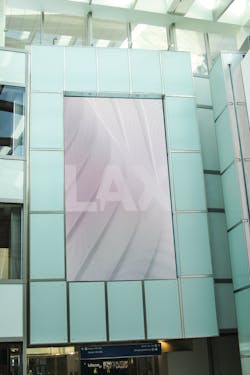Marc Auge once referred to an airport as a non-place; a location where people come to in order to leave. But more and more, airports are becoming places where people linger to enjoy contemporary artwork as they pass through on their journeys.
The very notion of artwork being inside the fence is a fairly new one. The aviation industry is heavily focused on process. Thus, when managing most projects in the busy airport environment, the focus tends to be on following a defined process. As a result airports wind up with digital installations where form closely follows function. However, recent trends in airport terminal digital displays have demonstrated a renewed effort to break away from the standard form flight information displays and move toward those designed to increase passenger engagement. Such efforts, if done right, can increase customer satisfaction and revenues to the airport.
Today’s airports are now using large-format digital, interactive kiosks and mobile digital solutions to engage and connect with passengers inside the “technology cocoon” that has developed as the number of personal electronic devices travelers carry rises. When researching options for a potential new installation, I discovered a new term to describe airport digital projects--immersive.
Immersive installations encourage discovery and deepen customer engagement via large-scale interactive media systems, such as the one unveiled at
Tom Bradley International Terminal (TBIT) at Los Angeles International Airport (LAX) this summer. This Integrated Environmental Media System (IEMS) program is described in an LAX press release as “focus[ing] on the engaging passenger experience.”
But don’t take their word for it. Richard Lebovitz, editorial director of Digital Signage for DigitalSignageConnection.com, sings its praises as well stating in an article for the Digital Signage Connection Blog: “Seldom have we come across as inspiring an installation of digital content as that found at the new Tom Bradley International Terminal at Los Angeles International Airport.”
And, the Moment Factory’s description of the online video portion of the TBIT install concisely describes the scale of this installation, stating, “The result is the largest immersive multimedia system of any airport in the Americas.”
As a consequence of these reviews, I decided that a digital system described as engaging, inspiring, and immersive was worth trying to coordinate a visit. Such a visit was possible because of fortunate timing with a conference, cooperative flight schedules that allowed an extended layover at LAX, and supportive local staff. And because of this visit, I am able to discuss the impact of the IEMS and how the connections created by these different elements rightly justify the above descriptions.
SUBHEAD:
The $737 million terminal at LAX is outfitted with the latest in multimedia technology. Sardi Design and MRA International designed the terminal’s iconic multimedia features; Fentress Architects designed the terminal and supported the media installation; Smart Monkey’s Inc. designed and engineered the audio-visual system; and Moment Factory produced the content.
The objective of the installation is to enhance the passenger experience and turn the terminal into a spectacular and welcoming place to pass the time.
Detailed information about the IEMS is provided by Los Angeles World Airports (LAWA) and its partners online through press releases, data sheets, and other content. Additionally, a search using Google or Bing with the terms “LAX Tom Bradley experience” can connect you directly to professionally created videos on YouTube and Vimeo covering the install and virtuals tours of the terminal.
The specifications on this install can be overwhelming. For example, the Time Tower alone is 6,480 square feet of digital surface created using Daktronics 6mm and 10mm video displays (the smaller the distance between the individual LED elements the higher the resolution).
To learn more about the details of the install beyond the specifications, I connected with Raymond Jack, LAWA airport operations manager. Jack graciously provided a complete tour of TBIT, providing details on the displays, as well as discussing the other ongoing development in the terminal and how it related to the experience.
What follows is my description of the installation and just how impressive and immersive it truly is.
Story Board. The first full element I viewed was the “Story Board,” a 120-foot array of multiple LED screens located in the center of the Great Hall. This display provided a striking first impression as I entered through the Westfield Dining District. The Story Board is a collection of eight differently sized displays suspended above and just beyond the center shopping island. At times the Story Board provided the impression of a single wall, as with my first viewing where I was presented with the image of a wide body aircraft taking off. The skill of the content creators was evident as the elements of the display began to transition into different shots of the aircraft presented on individual screens. This style allowed a wide-angle view of the content, whether it was the aircraft or the community landscape. This view could then transition into a tighter focus on individual elements in high detail. The content includes journeys through destination cities, stories of travel and transformation, and vignettes and panoramas from Los Angeles.
Destination Board. The “Destination Board” is located directly across the Great Hall from the Story Board. It is the most functional of the pieces in the media system, serving as both a Flight Information Display and visual display of destination cities. The form of the Destination Board moves beyond what is seen in many other large-format digital Flight Information Displays, however. The Daktonics’ LED’s allowed for a truly seamless display that provided flight information that is clear and easily readable from any angle or distance in the Great Hall. The presentation of content includes more than just flight information; the Destination Board also creates a connection between the data on the Board and the content displayed. For example, the destination cities creatively find their way into the graphics on either side of the “flight information” portion of the display. This creates a fluid real-time connection between the data, the destinations, and the passengers.
Time Tower. The centerpiece of the digital elements in the Great Hall is the “Time Tower,” a 72-foot-tall four-sided media feature.” If the display was off, the function of the structure would be clear. It is an elevator shaft serving multiple floors of the terminal. The illusions created by the displays almost completely hide the reality of this purpose. Simply stated, almost every visible surface of the tower is covered by LEDs. At the pedestrian level, the lower-resolution 10mm LEDs are behind diffused glass providing a subtle swirling visual effect that compliments the other activity on the tower. The LEDs above the diffused glass are the high-resolution 6mm variety. At first glance the content on the tower appears to stand alone. Linear angles move across the surfaces of the tower as well as waves and ribbons of digital motion, all of which are calming in effect. Then it becomes apparent that some of the content appears to flow seamlessly over to the adjacent Destination Board. At the top and bottom of each hour, the connection across devices really kicks in when the Time Tower displays one of its many showcase elements. The activity every half hour is varied. For example, the first show I witnessed altered the digital ribbons onscreen to the interworking of a clock, occupied by dancers and gears. During the second show, the surface transformed into a multi-story building with a keystone cop-type character in chase. Each show spilled over onto the other screens in the Great Hall completing the connection across the wide open space and generating a completely immersive environment.
Welcome Wall / Bon Voyage Wall. These elements are the only ones that are completely removed from the Great Hall. The Welcome Wall and the Bon Voyage Wall are located in a transitional space in the terminal, and although adjacent to one another, the walls are targeted to visitors in different parts of their journey through LBIT. The Welcome Wall is a tall structure--over seven stories in height--and although it is targeted to passengers in the processing part of their journey, it also provides the closest access to the LED screens. Likewise, the Bon Voyage Wall targets passengers in transition, and like the Welcoming Wall, it is tall and narrow, directed toward passengers entering the terminal. This is one of the few points where you can see up close how the magic is made through the individual LED pixels. Like other displays, these are connected, so that clouds, water, balloons, and even floating people, are connected across the displays.
Interactive Portals. The final pieces of the system are the Interactive Portals located north and south of the Great Hall. Each Portal has eight columns of six high-resolution LED monitors, each mounted at an angle. These monitors allow for a level of clarity even up close, and the angles permit the columns to be viewed individually, or from the right angle at a distance, to appear as a connected a video wall. The interactive content created for these Portals ranges from strings, to digital fluid, to spinning totems. Each column is then set in motion by the activity of passengers simply walking by. Like so much else in this space, the content is developed to create a connection with the passenger and the destinations.
LBIT’s new digital media displays create levels of connection not seen to date in an airport environment. The displays move well beyond simply connecting passengers to travel-related information. By connecting screens across the new terminal, the airport created an environment of seamless communication. Then, when developing content for the screens, the airport provided content related to the community as well as information passengers require, and actual passenger and aviation activity in and around the terminal. The immersive quality of the LBIT installation left me filled with confidence. There’s no way anyone could describe this terminal as a “non-place,” this installation makes it a place passengers want to journey to.
BIO: David Saleme, A.A.E.
Saleme joined the Columbus Regional Airport Authority (CRAA) in October 1996. He was hired under the General Counsel's office, with a focus on concessions and real estate. Since then, he has been responsible for terminal and concession development at Port Columbus International Airport, part of which includes terminal advertising and marketing. Saleme's primarily responsible for managing the in-airport advertising program, which includes, in addition to the award-winning video wall system, more than 20 digital advertising screens throughout the terminal, and the external digital billboard program.





